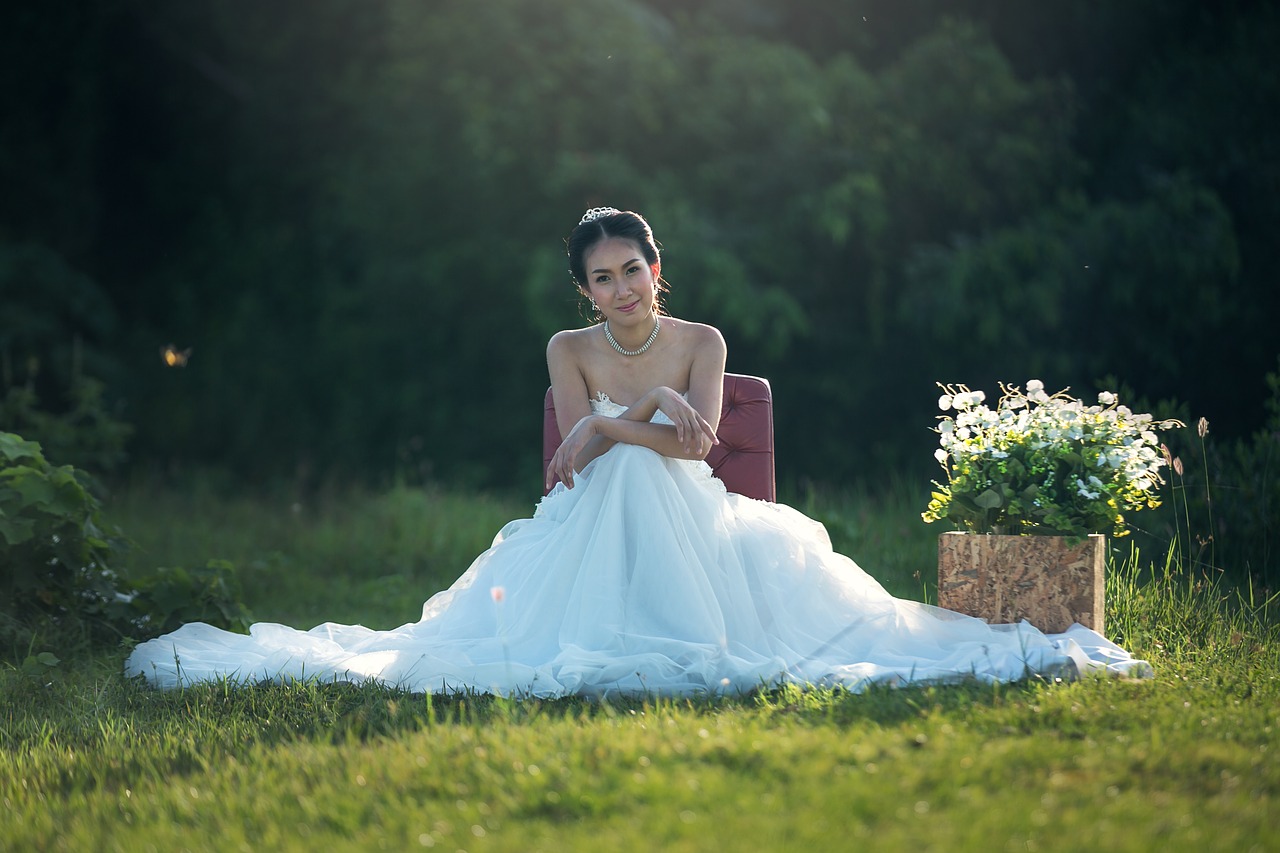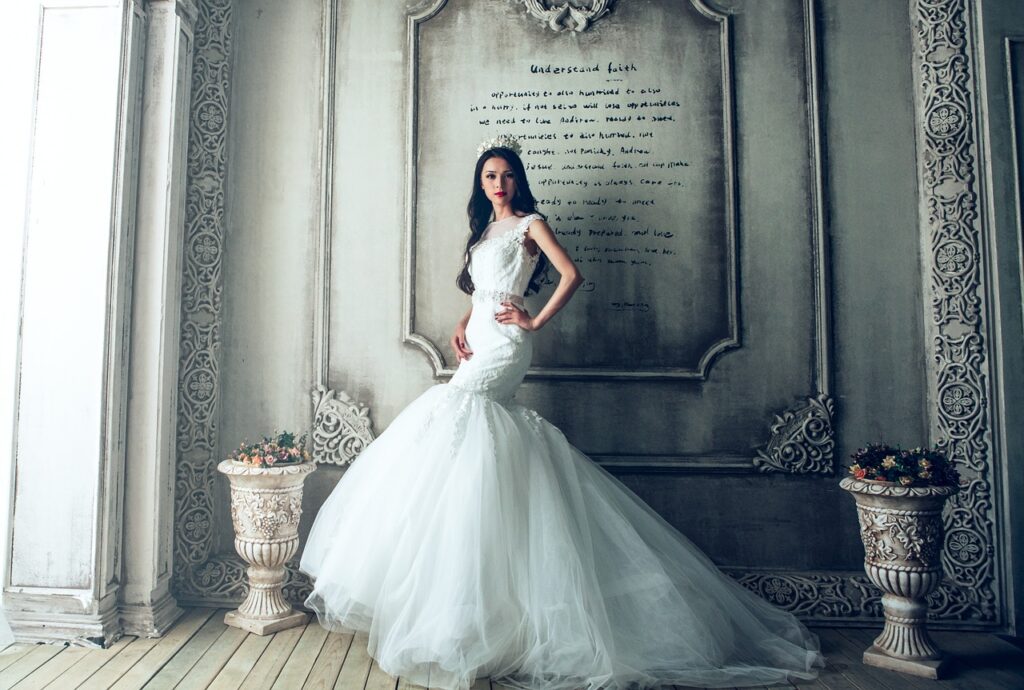Planning a wedding involves countless decisions, and choosing the perfect wedding dress is one of the most significant. However, even the most beautiful gown may require adjustments to achieve the perfect fit.
This guide will cover everything you need to know about wedding dress alterations, including essential tips, a fitting schedule, and how to make your fittings stress-free.
Let’s dive into the world of wedding dress alterations, ensuring you walk down the aisle in a gown that complements your unique style and shape.
Let’s get straight to the point
Wedding dress alterations are essential to ensure a comfortable, perfect fit that reflects your style on your big day. Key tips include scheduling fittings well in advance (8-10 weeks before), bringing your wedding shoes and undergarments, and staying realistic about weight goals.
The alteration process involves several stages, starting 3-4 months before the wedding for major customisations, with final fittings held two weeks out. Each fitting allows adjustments for movement and comfort, and trusted feedback from a friend can help.
Focus on key aspects like practising with your bustle, inspecting for flaws, and preparing accessories. With thoughtful planning, you’ll feel confident, comfortable, and radiant in a tailored dress.
Why Are Wedding Dress Alterations Important?

Finding the perfect dress is only the beginning. A gown straight from the rack is unlikely to fit perfectly, as dresses are typically designed with standard size and shape in mind. Alterations ensure your dress feels comfortable, fits your body flawlessly, and reflects your personality on your big day.
Key benefits of wedding dress alterations:
- Achieve the perfect fit: Tailored adjustments create a dress that feels custom-made.
- Comfort and confidence: Proper fit ensures you can move, dance, and enjoy your day.
- Enhance design details: Alterations can highlight the dress’s best features.
Tips for Planning Your Wedding Dress Alterations
Properly planning your wedding dress alterations ensures you’re well-prepared for each fitting. Here are some essential tips for a smooth experience:
Schedule Fittings In Advance
The wedding season is usually bustling with brides looking for sewist services, so booking your fittings early is best. Plan to schedule your first fitting at least 8-10 weeks before the wedding to allow time for multiple fittings if necessary. Give your tailor ample time to perfect your dress to avoid last-minute changes.
- Best time for fittings: Weekdays between 9 a.m. and 5 p.m. are ideal for fittings, especially during peak wedding months.
Bring Your Wedding Undergarments And Shoes
Undergarments and shoes affect the fit of your dress, so bring them to each fitting. This includes:
- Bridal lingerie: Nude strapless bras and shapewear are popular choices.
- Shoes: Wearing your wedding shoes helps ensure the hem is the right length.
Stay Realistic About Weight Goals
If you’re trying to reach a specific weight for your wedding, aim to do so at least five weeks before the date to allow accurate adjustments. Be open and honest with your sewist about any planned changes to your physique, as they can adjust accordingly to enhance your dress’s fit.
Limit Your Fitting Companions
Bringing along a trusted friend or family member can provide valuable feedback, but avoid bringing a large group. Too many opinions can be overwhelming and may complicate decision-making.
Understanding the Wedding Dress Fitting Schedule
The fitting process for a wedding dress is generally broken into several appointments, each focusing on perfecting the fit and final look of the gown. Here’s a general timeline to follow:
3–4 Months Before: Major Customizations
If your dress requires major modifications, such as adding sleeves, changing the neckline, or adjusting the silhouette, start working with your seamstress 3-4 months before the wedding. This timeframe allows for any necessary foundational changes without feeling rushed.
2–3 Months Before: Initial Fitting
Most brides schedule their first fitting 2-3 months before the wedding. At this stage, the seamstress will check the dress from top to bottom, assessing alterations to fit the bride’s unique shape. Common adjustments include:
- Shoulders, bust, and waist adjustments: Ensuring the dress contours to your body.
- Length and hem alterations: Adjusting based on the height of your wedding shoes.
1 Month Before Refinements
With one month left, the bulk of the alterations should be complete, leaving only minor tweaks. During this fitting, the seamstress will fine-tune details, such as the neckline or sleeve length, to ensure the dress matches your vision.
2 Weeks Before Final Fitting
The last fitting is a quality control measure to ensure everything is perfect. This is your final chance to make any adjustments, no matter how minor. Once you’re satisfied with the dress, it’s ready for the big day.
Preparing for Your First Wedding Dress Fitting
Your first fitting is a significant milestone. To make the most of it, follow these guidelines:
Timeliness Is Essential
Plan your fitting appointment with plenty of lead time. Generally, order your wedding dress at least 4-5 months in advance and aim to have your first fitting around six weeks before the wedding.
Prepare Your Hair And Makeup
To get an accurate sense of how the dress looks, style your hair and apply light makeup similar to what you’ll wear on the wedding day. While full makeup isn’t necessary, a polished look can help you visualise the final appearance.
Bring Wedding Accessories
Any accessories you plan to wear, such as veils, tiaras, or statement jewellery, should accompany you to the fitting. Accessories can influence the dress's appearance, so having them on hand will provide a complete picture of your bridal ensemble.
Wear The Right Shoes
The heel height you choose affects the hemline of your dress. Wear the shoes you plan to wear for the ceremony to ensure the dress's hemline is correct and complements your footwear choice.
Making the Most of Your Wedding Dress Fitting Experience

Each fitting session is essential for the perfect dress, so don’t hesitate to communicate with your seamstress. Keep the following tips in mind to make the most of your fitting experience:
Test Movement And Comfort
Since you’ll spend hours in your dress, test it in various movements, including walking, sitting, and dancing. This will help you identify areas requiring further adjustments, such as the bodice or hemline.
- Practice walking and climbing stairs: Ensures that the dress flows comfortably.
- Sit down and stand up: Confirms that you can move freely and comfortably.
Bring A Close Friend Or Family Member
Having a trusted person with you can provide support and a second opinion, especially if you feel uncertain. Choose someone who understands your style and will give constructive feedback without overwhelming you.
Visualise Different Alterations
As you try on your dress, consider various alterations that might improve the fit, such as adjusting the neckline, sleeves, or waist. Take advantage of your seamstress’s expertise to explore these options and find a look that suits you perfectly.
Be Honest About Your Fit Goals
Open communication is an essential part of any wedding dress alteration. If you’re hoping for a specific look or feel, be honest with your seamstress. Whether you prefer a classic style or something a bit more modern, discussing these ideas openly can help create a dress you’ll love.
Dos and Don’ts for a Smooth Wedding Dress Fitting Process
Approach your fitting appointments with a prepared mindset and practical strategies:
Do: Schedule Early
Book your first fitting appointment at least six weeks before the wedding. This allows enough time to make necessary adjustments without feeling rushed.
Don't: Skip Your Wedding Shoes
With your wedding shoes, getting accurate measurements for the hemline is possible. Always bring them to every fitting.
Do: Inspect The Dress For Flaws
Spend time checking for stains, loose seams, or other minor flaws. Addressing these issues early ensures you won’t be surprised on the wedding day.
Don't Bring Too Many People
Too many voices can complicate decision-making. Limit your entourage to a couple of trusted people who understand your vision.
Do: Learn How To Use Your Bustle
If your dress has a bustle, ensure you or someone helping you on the big day understands how to arrange it. Practising this can save time and hassle when it’s time to transition your dress for the reception.
Don't Panic About Small Details
Last-minute nerves are normal, but don’t let them cloud your excitement. Trust the process, and remember that alterations are designed to bring out the best in your dress.
Conclusion
Wedding dress alterations may seem complex, but they are essential to creating a stunning and comfortable dress. With the right planning and attention to detail, you can ensure your dress fits perfectly, allowing you to enjoy every moment of your special day.
Key takeaways for successful wedding dress alterations:
- Start early: Schedule fittings well in advance.
- Communicate clearly: Be honest about your needs and expectations.
- Embrace the process: Alterations bring out the best in your dress.
With these tips, you can feel confident and radiant as you walk down the aisle, knowing that your dress reflects your personality, style, and beauty on one of the most important days of your life.
FAQS ABOUT WEDDING DRESS ALTERATIONS
On average, typical wedding dress alterations cost between $150 and $600. If you're customizing your gown or modernizing your mother's dress, it may be up to $1,000. Some bridal boutiques may charge you a flat fee, while other seamstresses may charge you for individual alteration services.
When do you need to get your wedding dress altered? We recommend coming in for your fitting two months in advance, but not less than 1 month before to have your dress altered. Then, because everyone is trying to lose weight, we suggest having your final fitting no earlier than two weeks before the wedding.
Usually, you can alter a wedding dress two sizes down and a size up. A dress could also be recut if you need to take more than three sizes in. However, your tailor could make other special alterations depending on your size, the dress's current size in question, and its peculiarity.
Not usually, but quite often! While most bridal salons do offer modifications on-site, there are times when an expert tailor is required. If you must travel outside the bridal salon for alterations, hire a tailor who specialises in wedding attire. You won't find another outfit like it anywhere else; the fabrics and construction are that special.
When getting fitted for your wedding dress, remember to bring your wedding shoes, as well as any undergarments or bridal shapewear you plan on wearing. The tailor can then make the necessary alterations based on your feedback. Alternately, if you haven't previously done so, don't fret because your tailor will be able to advise you on the most attractive shapewear to buy.

